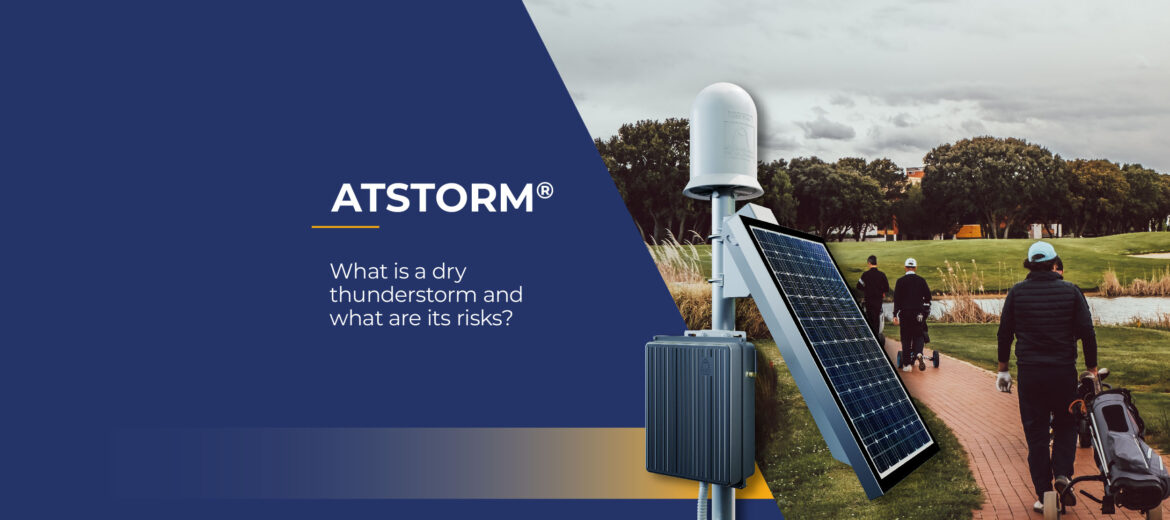By definition, “a dry thunderstorm is a storm that has no or very little precipitation associated with it, but does carry electrical activity”. The absence of precipitation can create a false sense of security that poses a serious risk to the safety of people and structures. In this scenario, a system with sensors capable of detecting all phases of the storm and issuing warnings before the first impact can make a difference.
Lightning is a powerful atmospheric electrical discharge that can pose a great danger depending on where it strikes. We often associate thunderstorms with heavy rain, gusts of wind and electricity, but all three factors do not always occur at the same time or with the same intensity.
The phenomenon known as a dry thunderstorm occurs when there is not enough humidity in the middle and lower layers of the atmosphere for the rain to be significant, or when there is not enough cold air at high altitudes (upper layers) for the storm to have a good structure and vertical development.
As a result, the rain evaporates before reaching the ground: there is little humidity at low and medium levels and the rain evaporates before reaching the ground. In these cases, small strands of rain are often seen coming out of the cloud base and not touching the ground, known as virga. Although not exclusive to the summer period, this phenomenon tends to occur mainly in summer and in dry areas where high temperatures are reached and is one of the main reasons for fires caused by lightning strikes.
Open-air activities are particularly exposed to lightning strikes. Wind farms, photovoltaic installations, refineries, mines, military installations, large sporting events, golf courses or airports run the risk of one or more lightning strikes causing serious personal and economic damage if preventive measures are not taken sufficiently in advance.
In the event of a dry thunderstorm, the absence of rainfall can lead to a false sense of security, resulting in a failure to take the necessary measures to protect both people and sensitive facilities, as the risk is not perceived in the same way.
Storm detection systems are used to implement protocols for this protection. However, they must be able to detect all phases of a storm to be effective.
Storm detection: a smart system and more reliable warnings thanks to dual-sensor technology
Detection systems with an electromagnetic field sensor are capable of detecting storms approaching the target to be protected. However, they are not effective when it forms over the target, the first impact can be critical and can cause extensive damage.
The ATSTORM® storm detection system uses electrostatic field sensors and electromagnetic field-based sensors. Its warning alerts of forming or approaching storms in the area to be protected (20 km radio) are based exclusively on the measurement of the ambient electrostatic field. This measure is the only robust preventive protection because it detects all storm phases defined in the IEC 62793:2020 standard, from initial to good weather, once the storm has passed. Electrostatic field sensors are the only ones capable of determining the actual risk of lightning strikes before they occur. The electromagnetic field sensor, on the other hand, extends the monitoring area up to a radius of 40 kilometres and allows a pre-warning state to be defined for distant active storms.
In addition to having dual sensor technology, the expert local storm detection system ATSTORM® by Aplicaciones Tecnológicas is operated remotely by experts through IoT (Internet of Things), so that its correct operation is always ensured, while making all adaptations, calibrations and updates automatically, without requiring user intervention.
This way, by sending data to a centralised server, it allows alarm algorithms to be modified to improve alarm performance, cross-reference data with other sources to improve the system, adapt algorithms to changes that may occur at the site and monitor the status of equipment for predictive maintenance.
If you would like to find out more about local storm detection and how ATSTORM® works, you can contact us at the following link and download the free ebook Advanced Lightning Risk Management.
You can also attend any of our webinars about thunderstorm detection by clicking on the following link.
